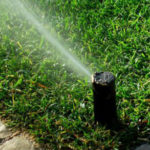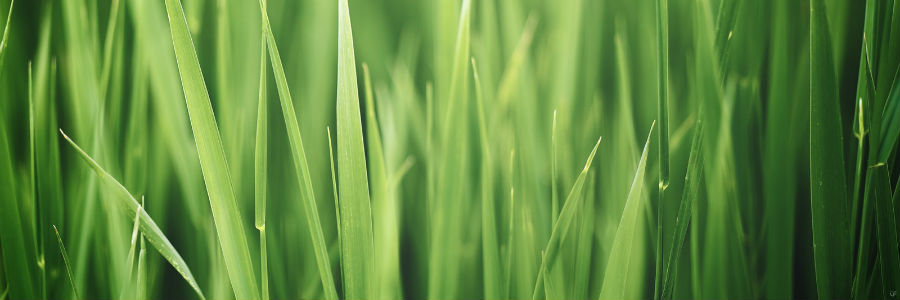 TOP 5
TOP 5
SPRING LAWN CARE MISTAKES TO AVOID SO YOU CAN MAINTAIN A HEALTHY AND BEAUTIFUL LAWN.
DON’T WATER TOO MUCH
We know everyone gets excited when winter is finally over, spring has come, and the grass starts to grow. One of the biggest mistakes we see people make is watering their lawn too much. This is often the case year round, but it is particularly important in springtime when your lawn is trying to develop and grow its root system.
Lawns in our northern climates typically have two growing periods. One in spring and one in fall. This is when your lawn will expend energy to develop and grow its root system.
When a lawn is over watered the ground becomes saturated and prevents oxygen from reaching the roots. Without oxygen, the roots cannot grow. In addition to a lack of Oxygen, over watering will also wash away many of the nutrients in the soil the lawn needs to develop its roots. This leaves your lawn with shallow roots and more susceptible to stress and disease. In general, an unhealthy lawn.
So how do you know when your lawn needs water? That depends on the depth of the existing root system.
In theory, you should not water your lawn until the top 50%-75% of the soil that surrounds the roots are dry. With our cool spring weather, it can easily take a week for the top couple of inches of soil to dry after each rainfall, and we often get rain every week.
Fortunately, there are irrigation controllers (ET controllers) that do all these measurements and calculations for you.
Unfortunately, they are relatively new to the residential market and most people do not have them yet. If you do not have an ET controller and you want to prevent your lawn from being saturated, we suggest that you do not leave your irrigation controller on automatic until the end of May, beginning of June. If you do need to irrigate during those times, do so with a manual cycle on an as needed basis.
SEEDING IS BEST DONE IN AUTUMN
Cool-season grasses can be planted as soon as the temperatures are consistently in the 15 degree Celsius range, however, the soil temperature should be at least 10 degree Celsius and above.
Autumn is a much better time of year to plant new grass.
Normally, we only suggest seeding bare or dead patches of your lawn in spring. If you need to seed in spring, remember your newly planted areas will need more water all year long.
You should plant as soon as temperatures allow to give the seedlings a chance to get established before hot weather arrives.
CLEAN UP ONCE YOUR YARD IS DRY
No one enjoys this, but it is important. It gives you the chance to survey your property.
Avoid most yard work in the spring until the soil dries out. Walking, raking and riding mowers can compact or disturb soggy soil and damage any new grass that may be growing. Compacted soil will restrict the amount of Oxygen that can reach the roots. Once the soil is dry, give your lawn a good spring cleaning to encourage grass growth and discourage pests and diseases.
As the weather warms, spread snow piles out to encourage melting. Leftover snow piles can smother the grass underneath and cause mold growth.
Remove leaves and fallen branches, and gently rake to fluff up the grass. If you have over a 1/2″ of thatch, we recommend a more thorough raking to reduce the amount of thatch build up.
If you find any matted patches of grass, where the grass blades are all stuck together, you may have “snow mold”. New grass often has difficulty penetrating these matted patches, but raking will normally be sufficient to solve the problem.
WEEDS
Controlling weeds like crabgrass and broadleaf weeds are done differently.
Spring is the best time to prevent annual weeds, like crabgrass, by using pre-emergent weed control.
Pre-emergent herbicides work by preventing the weed seeds from germinating by creating a barrier over your lawn. If you are going to use this approach, and you plan on aerating your lawn, you must apply the herbicide after aeration or the barrier will be ineffective.
If you plan on seeding in the spring and applying a pre-emergent herbicide, you will not only kill the weed seeds but also your grass seeds. You have to choose one or the other. This is another reason we suggest seeding primarily in autumn.
Pre-emergent herbicides work for about three months, so plan on a second application during the summer.
Autumn is the best time to kill broadleaf weeds, like dandelion, and is done with post-emergent herbicides. If you want to remove them in the spring, picking them is best, but you have to get the entire root system.
Since the weed is already established, you are trying to kill an existing plant which often does not show up until late spring, early summer. Most post-emergent herbicides take about 3-4 weeks to completely eliminate the weed.
This happens in 4 steps. Step one is absorption, this takes 3-4 hours. Then the herbicide spreads within the weed and this takes about 1-2 days. The weed is then either killed or its growth is stunted over the next 3 days. Lastly, the weed has to decompose or rot in the soil and this is a function of soil temperature and moisture content
BE CAREFUL IF YOU CHOOSE TO FERTILIZE IN SPRING
Fertilizer itself is not bad, but what is sold in stores is often not what you should by using in spring.
The type of grass grown here in the Montreal area is primarily Kentucky bluegrass and is a cool season grass. It grows most vigorously in spring and fall.
There are three primary types of chemicals in fertilizer and each one has a different effect on your lawn. These three chemicals are the numbers you see on your bag of fertilizer, such as 12-32-16. This represents 12% nitrogen, 32% phosphates, and 16% potassium.
Nitrogen promotes blade growth and the green color. Potassium helps grass root firmly in the soil and is an all-in-all health booster that helps your lawn better resist harsh weather and drought. Phosphorus is important to develop healthy roots so it can better transfer nutrients and stay healthy. Like potassium, phosphorus also helps the grass fight disease.
Spring and fall are when the grass will try and expand its root system so if you apply a fertilizer with a high nitrogen content the lawn will expend whatever energy it has left after the winter to grow the blades of grass and turn green. This happens at the expense of the root system, and as such, stunts root growth. Weaker roots, weaker lawn.
If you are going to fertilize in spring, look for a fertilizer grade that has the lowest possible amount of nitrogen and as high as possible content of phosphates and potassium.
12-32-16 would be great, but good luck finding it in the stores. What you will find is typically in the range of 32-0-5 or 30-0-3, all of which are very high in nitrogen and will stunt your lawns root growth.

